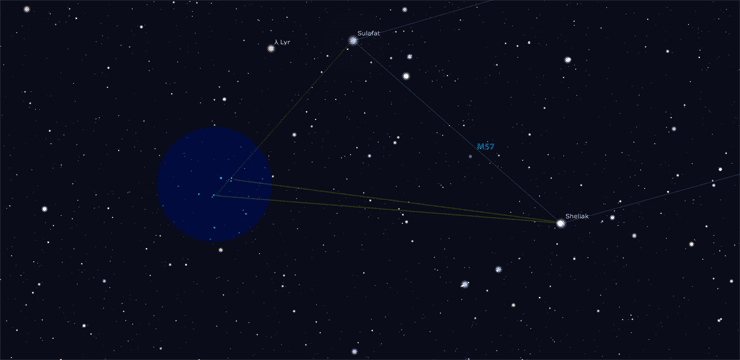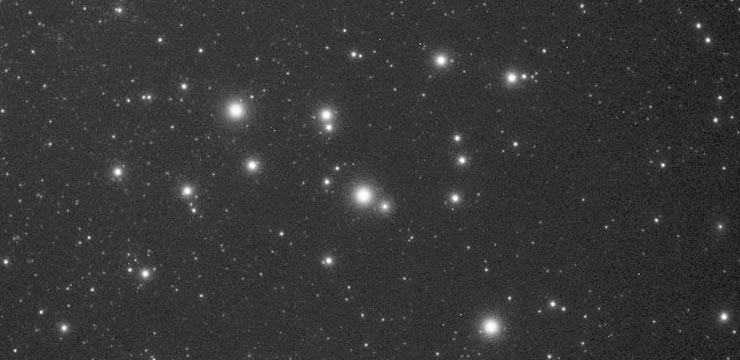
The Ships of Sheliak
September 2011 :
After two and a half decades of seriously observing the night sky, I have come to the realization that Lyra has become my favorite constellation. For one, it contains my favorite star, Vega, which has been a beacon of summer since before I knew anything about the galaxy we live in or even our own solar system. Vega’s brilliant blue-white light shines directly down on us during the summer evenings, accompanied by the sound of crickets and frogs, and when I lived at Spring Lake, a bullfrog on the other side. Another welcoming aspect of Lyra is its strategic placement well to the north and at around 18 hours of right ascension (where the ecliptic is at its farthest point south), which permits it to be observed well into the early winter months despite its placement at the westernmost point of the Summer Triangle.
Extending a hand-width to the south of Vega is one of the most conspicuous constellation outlines in the entire sky-a near perfect parallelogram four degrees long by two degrees wide, consisting of third and fourth magnitude stars including a notable eclipsing binary star that varies between third and fourth magnitude about every 12 days.
Lyra is a splendid constellation to explore casually with binoculars or an easily slewed small telescope. Located several degrees from the galactic equator, it lacks the “milkyness” of lying among the densest part of the Milky Way yet it contains an above average density of relatively bright stars which provide a pleasing contrast against Lyra’s darker and more distant backdrop. I find that Lyra is best explored using a wide-field eyepiece that gives a 2.5 to 3 degree field of view.
For backyard explorers, the best-known telescopic destination within Lyra, and for good reason, is M57, the Ring Nebula. M57 is conveniently located between Sulafat (gamma Lyrae) and Sheliak (beta Lyrae), and bright enough to be seen in the smallest of telescopes and even in binoculars as small as 10x50mm. Our target for this tour is a pair of nearly-symmetric asterisms not far from the Ring Nebula.
Anyone who has seen Lucasfilm’s Star Wars Episode IV: A New Hope recalls the opening scene where Princess Leah’s ship is being overtaken by the imperial star destroyer just before it is boarded by Darth Vadar. A pair of these slender, wedge-shaped ships can be seen flying away from Sheliak and in the direction of Altair (see finder chart). Each “ship” is a trio of 9th magnitude stars approximately 10 minutes long by 2 minutes wide. They are situated parallel to each other at an angular distance of slightly more than the length of one ship and staggered such that the tip of the northernmost triangle is even with the “back” or smallest leg of the southern triangle. They are staggered in such a way as to be aligned roughly with a line extending back towards Sulafat. The northern one forms an isosceles triangle while the southern one is marked by one star being slightly out of position when compared to the northern triangle. Together, their similar proportions, orientation, and brightness gives them a conspicuous appearance that stands out easily against the otherwise random starfield surrounding them.
The next time you visit the Ring Nebula, take a side trip about three Moons away to the Sheliak-Altair line. There you will find several distant suns that present themselves along our line of sight as a pair of interstellar travellers of the science fiction kind.
Did you know...
Vega is about as bright as Arcturus to the west and Capella to the east. The only star visible from the northern hemisphere that outshines them is Sirius.
Just a few degrees to the northeast of Vega is the large patch of sky being studied by the Kepler Space Telescope to learn the properties of exoplanets.
Sheliak (beta Lyrae) is an eclipsing binary star, varying from magnitude 4.6 to 3.4 every 12.9075 days. It is 882 light-years away, placing it 25 times more distant than our beacon of summer.
When to Observe
Constellations
Related Topics




